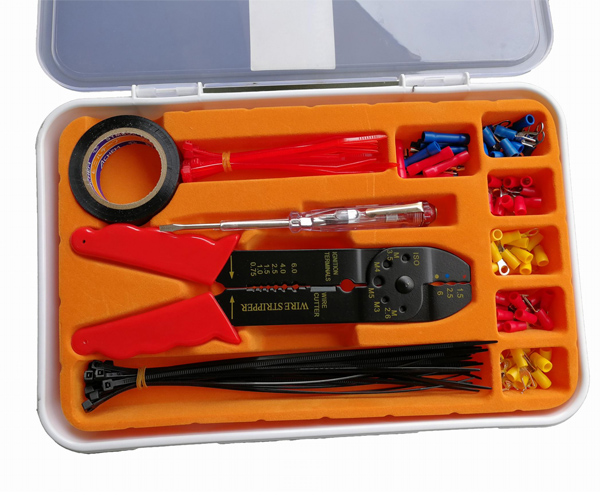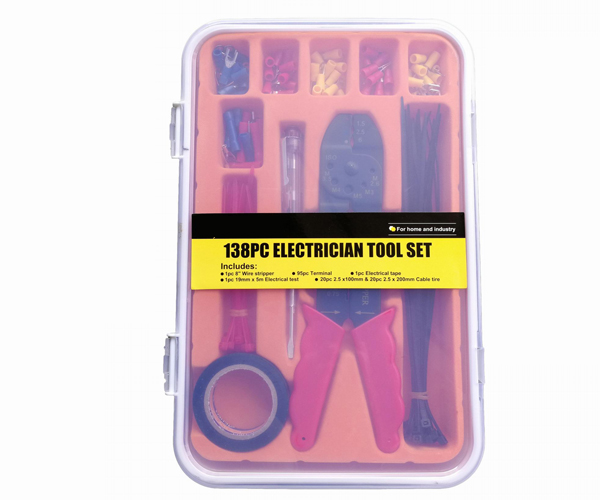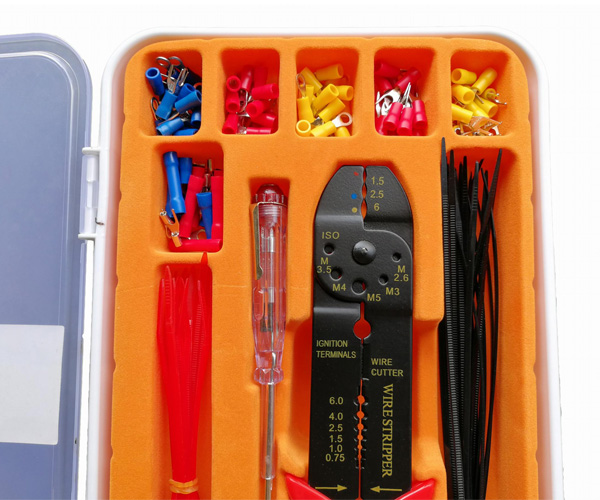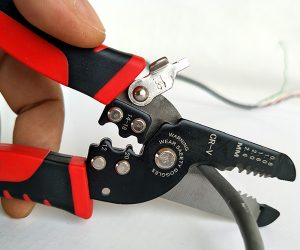Wire strippers are an essential tool in a wide range of industries, especially when it comes to electrical work. Whether you’re a professional electrician, a DIY enthusiast, or involved in manufacturing processes, understanding what wire strippers are used for can enhance your efficiency and safety. In this article, we will dive deep into the various types of wire strippers, their uses, and how to choose the right one for your specific needs. So, what’s the real story behind these tools? Let’s explore!
1. What Are Wire Strippers Used For?
Wire strippers are tools designed to remove the insulation from electrical wires. They are indispensable for anyone working with electrical wiring, as they allow for precise and safe removal of insulation without damaging the wire itself. Ready for the good part? Let’s break it down further.
Wire strippers come in handy for a variety of purposes. For example, when installing electrical outlets, switches, or even repairing wires, you’ll need to strip off a small portion of the insulation to make the necessary connections. These tools ensure that you don’t accidentally cut or damage the wire while doing so.
In addition to professional electricians, DIY enthusiasts also use wire strippers when working on home projects, such as installing new light fixtures, appliances, or even wiring new circuits. What’s the kicker here? Without a wire stripper, attempting to manually strip insulation can lead to both inefficiency and safety hazards.
To highlight their importance, consider this: without properly stripped wires, electrical connections will not conduct electricity effectively, which can cause short circuits or even fires in extreme cases. Therefore, using wire strippers correctly is not just about convenience—it’s about maintaining the integrity of your electrical system.
Table 1: Common Uses of Wire Strippers
| Use Case | Description | Industry/Application |
|---|---|---|
| Electrical Wiring Installations | Stripping insulation for secure wire connections | Electrical work |
| DIY Projects | Installing lighting, outlets, and other electrical components | Home improvement |
| Repairing Electrical Wires | Removing damaged insulation for repair | Residential and commercial |
| Custom Cable Production | Stripping insulation from bulk cables for various uses | Manufacturing |
2. What Are the Different Types of Wire Strippers?
Now that we know wire strippers are crucial, let’s discuss the various types available. There are several different wire strippers to choose from, each with its own unique features tailored to specific needs. But here’s the kicker…choosing the right one for the job can make all the difference!
The three main types of wire strippers are manual, automatic, and adjustable. Each one has advantages depending on the task at hand. Manual wire strippers are typically the most common. They are simple to use and often preferred for smaller tasks where precision is necessary. Automatic wire strippers, on the other hand, are perfect for larger projects or repetitive tasks, as they automatically strip the insulation without requiring much effort from the user. Adjustable wire strippers offer the versatility of both worlds—they can be set to different gauges of wire, allowing for maximum flexibility.
What’s the real story? When choosing a wire stripper, it’s important to consider factors such as the volume of work, the wire size, and your comfort with the tool. Let’s take a closer look at each type.
Table 2: Types of Wire Strippers and Their Uses
| Type of Wire Stripper | Features | Ideal Use |
|---|---|---|
| Manual Wire Strippers | Simple, precise, hand-operated | Small, precise tasks |
| Automatic Wire Strippers | Self-adjusting, fast | High-volume or repetitive tasks |
| Adjustable Wire Strippers | Customizable for different gauges | Versatility for varying wire sizes |
3. Why Do You Need the Right Wire Stripper for the Job?
Choosing the right wire stripper for your project might seem like a small detail, but trust us—this is where it gets interesting. The wrong tool can lead to damaged wires, inconsistent stripping, and even safety hazards. So, why does it matter?
Using the right wire stripper ensures precision. Whether you’re working with delicate copper wires or heavier gauge cables, having a tool that suits the task will help you strip the insulation without causing any harm to the wire. Not to mention, a good wire stripper will minimize fatigue, especially if you’re working on a large-scale project.
And here’s the kicker… if you use a tool that’s too aggressive or too dull, you might not get the clean cut that you need. For example, a poorly stripped wire can lead to electrical failures, making your work harder than it needs to be. What’s more, improper insulation stripping can result in dangerous electrical shorts or even fires.
Let’s take a closer look at why the right wire stripper is crucial in ensuring the longevity of your electrical system and your safety.
Table 3: Benefits of Choosing the Right Wire Stripper
| Benefit | Explanation |
|---|---|
| Precision and Accuracy | Ensures clean cuts and avoids damage to the wire itself |
| Safety | Reduces the risk of electrical shorts or fire hazards |
| Efficiency | Saves time and energy in both small and large projects |

4. How Do Wire Strippers Work?
Wire strippers may seem simple, but there’s more to them than meets the eye. Essentially, wire strippers operate by using sharp blades or jaws that apply controlled pressure to remove the insulation from wires. So, how do they work exactly?
Here’s the interesting part: wire strippers come with an adjustable feature that allows you to set them to different wire gauges. This is crucial because different wire sizes require different stripping pressures. If you apply too much force to a thin wire, it may break. If you don’t apply enough, you won’t be able to remove the insulation.
Ready for the good part? The stripping action works by using a series of teeth that grip the wire, gently peeling away the insulation without cutting into the wire itself. The result is a cleanly stripped wire ready for connecting or soldering. The best wire strippers will provide a smooth, effortless experience, helping you complete the task without frustrating mishaps.
Table 4: Parts of a Wire Stripper
| Part | Function |
|---|---|
| Handles | Provide grip and control |
| Blades/Jaws | Cut through wire insulation |
| Adjustment Mechanism | Set the stripper to the desired wire gauge |
5. What Are the Key Features to Look for in a Wire Stripper?
Choosing the right wire stripper involves more than just selecting a tool that fits your hand. There are specific features to look for that make the tool more effective and easier to use. But here’s the kicker…the right features can save you time and effort, improving both the quality of your work and your overall productivity.
One of the most important features to look for is the blade material. High-quality blades made from carbon steel or stainless steel ensure durability and long-lasting performance. Another crucial feature is ergonomics. A comfortable, non-slip handle allows for better control, reducing hand strain during extended use. Furthermore, having an adjustable stripper can be a game changer, particularly when you work with wires of different gauges.
Table 5: Key Features of Wire Strippers
| Feature | Benefit |
|---|---|
| High-Quality Blades | Ensure clean cuts and long-lasting durability |
| Ergonomic Handles | Reduce hand fatigue and provide better control |
| Adjustable Settings | Work with a wide range of wire gauges |
6. How Do You Use a Wire Stripper Correctly?
Using a wire stripper is a skill that takes practice to master, but with the right technique, you can make the process much easier. Ready for the good part? Let’s break it down step by step.
To use a wire stripper, first, select the appropriate setting for the wire gauge. Then, place the wire into the stripper’s jaws, ensuring it’s positioned correctly. Next, squeeze the handles gently to strip the insulation off the wire. The key is to apply just the right amount of pressure—too little won’t strip the wire, but too much might damage it.
Now here’s the kicker: If you’re stripping multiple wires, it’s best to work in batches to increase your speed and consistency. Additionally, always wear safety goggles when stripping wires, as bits of insulation or metal can sometimes fly off.
7. How to Choose the Right Wire Stripper for Your Needs?
Choosing the right wire stripper can make a significant difference in the efficiency and safety of your electrical work. So, what’s the deal with choosing the right one? Let’s explore!
When selecting a wire stripper, you should first consider the type of wire you’ll be working with. Different wire gauges require different stripper settings, so make sure to choose one that can accommodate the thickness of your wires. For instance, if you frequently work with thin wires, a precise manual stripper might be best, while thicker wires may require automatic or adjustable strippers.
Another important factor is the task at hand. For occasional home projects, a simple manual wire stripper may suffice. However, for professional electricians working on large-scale projects, an automatic or adjustable stripper will save time and effort. The right tool for the job will make your work smoother and faster, ensuring you get clean cuts every time.
Ready for the good part? Think about the ergonomics of the tool. If you’re going to be using it for extended periods, a comfortable, non-slip handle can make a huge difference. Look for features that enhance your grip and reduce hand fatigue, as this will allow you to work longer without discomfort.
Table 7: Choosing the Right Wire Stripper for Different Projects
| Project Type | Best Wire Stripper Type | Key Features |
|---|---|---|
| Occasional Home Projects | Manual Wire Strippers | Precision, affordable, easy to use |
| High-Volume Electrical Work | Automatic Wire Strippers | Fast, efficient, reduces manual effort |
| Versatile Tasks | Adjustable Wire Strippers | Flexibility, accommodates various wire gauges |
8. What Are the Advantages of Manual Wire Strippers?
Manual wire strippers are often the first choice for individuals who prefer simplicity and control. But here’s the kicker… even with their basic design, they provide several distinct advantages that make them indispensable in certain situations.
The main advantage of manual wire strippers is their precision. When you’re working with delicate wires or need to strip a small portion of insulation, manual strippers give you the control you need. These tools are perfect for small, detailed tasks where precision is crucial. Plus, manual wire strippers are typically less expensive than automatic models, making them a budget-friendly option for home use.
What’s the real story? Manual wire strippers are highly portable and easy to maintain. Since they don’t require batteries or complicated mechanisms, they’re a great option for casual users. Their simple, no-frills design makes them reliable and easy to carry around, especially when working in tight spaces or on smaller projects.
For instance, if you’re an electrician working on a minor repair or a DIY enthusiast installing new lights in your home, a manual wire stripper is a solid, dependable tool that gets the job done efficiently.
Table 8: Pros and Cons of Manual Wire Strippers
| Pros | Cons |
|---|---|
| Precise and controlled cuts | Requires more manual effort |
| Affordable and budget-friendly | Not as fast as automatic models |
| Simple, easy to maintain | Limited to smaller projects or gauges |

9. What Are the Advantages of Automatic Wire Strippers?
Automatic wire strippers have revolutionized the way professionals and hobbyists handle large projects. What makes these tools stand out? Ready for the good part?
One of the most significant advantages of automatic wire strippers is speed. These tools automatically adjust to the wire gauge, stripping the insulation off with minimal effort. This feature is especially beneficial when working with large batches of wires or in situations where time is a critical factor. Whether you’re working in an industrial setting or handling multiple cables for a home renovation project, an automatic stripper can significantly speed up the process.
Another advantage is precision. Automatic wire strippers are designed to handle a wide range of wire sizes, stripping insulation cleanly without damaging the wire itself. What’s the kicker here? These tools are built to provide consistent results, so whether you’re stripping wires for a small electrical project or large-scale installations, you can trust the tool to deliver accurate cuts every time.
However, while automatic wire strippers are fast and precise, they can be more expensive than manual strippers. But, for professionals who need to handle high volumes of wire work, the investment in an automatic stripper is well worth it.
Table 9: Advantages of Automatic Wire Strippers
| Advantage | Explanation |
|---|---|
| Speed | Automatically adjusts to wire gauge for faster operation |
| Precision | Strips insulation without damaging the wire |
| Consistency | Provides reliable, repeatable results on every wire |
10. What Are Adjustable Wire Strippers and When to Use Them?
Adjustable wire strippers offer a unique combination of flexibility and efficiency. But here’s the kicker… they provide the best of both worlds, combining the precision of manual models with the speed of automatic ones.
The main feature of adjustable wire strippers is their ability to adjust to different wire gauges. This makes them an excellent choice for professionals who work with a variety of wire types and sizes. By simply adjusting the tool’s settings, you can strip a range of wire gauges without needing multiple tools for each one.
Ready for the good part? Adjustable wire strippers are especially useful in situations where you might be dealing with varying wire sizes in one project. For example, in a construction or electrical installation where different wiring is required for different areas, an adjustable stripper ensures you always have the right tool for the job.
What’s the real story? These tools provide flexibility, ease of use, and convenience, which makes them highly sought after in both professional and DIY settings.
Table 10: Key Features of Adjustable Wire Strippers
| Feature | Benefit |
|---|---|
| Adjustable settings | Can be used for a variety of wire gauges |
| Versatility | Ideal for jobs requiring different wire types |
| Cost-Effective | Combines features of manual and automatic models |
11. How Do You Maintain and Care for Wire Strippers?
Proper maintenance of wire strippers is essential for ensuring that they last and perform effectively. But here’s the kicker… taking a little time to care for your tool can save you both time and money in the long run.
The first step in maintaining wire strippers is to keep them clean. After each use, wipe down the blades and handles with a clean cloth to remove any debris or grease. For stubborn grime, you can use a mild cleaning solution to prevent buildup. Regular cleaning will also help maintain the precision of the tool by ensuring that nothing obstructs the blades.
Ready for the good part? You also want to inspect the blades periodically for signs of wear or dullness. If the blades are no longer sharp, you may need to sharpen them or replace them. A dull blade can make the stripping process much more difficult, potentially damaging wires or affecting the quality of the strip. Keep the spring mechanism lubricated and in good working order to ensure smooth operation, especially for automatic and adjustable models.
Table 11: Maintenance Tips for Wire Strippers
| Maintenance Task | Reason/Benefit |
|---|---|
| Clean the tool after use | Prevents buildup and keeps the blades sharp |
| Inspect and sharpen blades | Ensures clean cuts and prevents damage to wires |
| Lubricate the spring mechanism | Maintains smooth functionality for automatic models |
12. What Are the Safety Precautions When Using Wire Strippers?
Using wire strippers is generally safe, but there are precautions you should take to avoid accidents. So, what’s the deal with safety?
The first step is always to wear protective equipment. Safety goggles are essential, as small wire fragments can fly off during the stripping process. In addition, ensure that your hands are dry and free from oils or liquids, as these can make the tool slip. Always use the wire stripper on wires that are not connected to a power source to avoid electrical shocks.
Ready for the good part? If you’re working with larger wire gauges, consider wearing gloves to protect your hands from abrasions, especially when using manual wire strippers. This will give you extra grip and ensure your safety as you work.
Table 12: Essential Safety Precautions
| Safety Measure | Explanation |
|---|---|
| Wear safety goggles | Protects your eyes from flying debris |
| Keep hands dry and clean | Prevents the tool from slipping and ensures a firm grip |
| Ensure the wire is not powered | Reduces the risk of electrical shock |
13. Can Wire Strippers Be Used for Other Materials Besides Wire?
You might be wondering if wire strippers can serve multiple purposes. Well, the short answer is yes! Ready for the good part? Wire strippers can often be used for other materials, depending on the type of stripper and the specific task.
Some wire strippers are designed to handle other materials like coaxial cables, which are commonly used for internet and TV connections. Certain models can also strip insulation from plastics or rubber coatings. However, it’s important to note that wire strippers are generally designed with a focus on electrical wiring, so using them for other materials may affect their performance or longevity.
What’s the kicker? If you plan on using your wire stripper for more than just electrical work, make sure to choose one that’s versatile enough to handle multiple materials without causing damage.
Table 13: Materials Wire Strippers Can Handle
| Material Type | Applicability |
|---|---|
| Coaxial Cables | Ideal for stripping insulation from coaxial cables |
| Rubber or Plastic Coatings | Some wire strippers can handle non-metallic coatings |
| Electrical Wiring | Primary use case for wire strippers |
14. What Are Some Common Issues with Wire Strippers?
Wire strippers, like any tool, can sometimes experience problems. So, what’s the deal with these issues?
One of the most common issues is dull blades. Over time, the blades of a wire stripper can become dull due to regular use. This can make the stripping process more difficult and may even result in damaged wires. Another issue is the spring mechanism, which can become loose or wear out over time. If the tool doesn’t open and close smoothly, it can cause difficulty during use.
What’s the kicker? Some wire strippers may also experience issues with their adjustable settings. If the stripper isn’t set correctly for the wire gauge, it can lead to inconsistent stripping, potentially damaging the wire or leaving excess insulation. Regular maintenance and proper usage can minimize these problems.
Table 14: Common Issues with Wire Strippers
| Issue | Solution/Prevention |
|---|---|
| Dull blades | Regular sharpening or blade replacement |
| Loose spring mechanism | Lubrication or replacement of spring |
| Incorrect adjustment settings | Always double-check settings to ensure proper use |
FAQ
Q1: What is a wire stripper?
A wire stripper is a tool used to remove the insulation from electrical wires, ensuring the wire itself remains undamaged.
Q2: How does a wire stripper work?
Wire strippers use sharp jaws or blades that apply controlled pressure to strip the insulation without damaging the wire.
Q3: What are the different types of wire strippers?
Wire strippers come in manual, automatic, and adjustable types, each designed for specific tasks and wire gauges.
Q4: Can wire strippers be used for other materials?
While primarily used for wires, some wire strippers can handle other materials like coaxial cables and plastic insulation.
Q5: How do I choose the best wire stripper?
When choosing a wire stripper, consider factors like wire gauge, job complexity, and whether you need manual or automatic features.
Looking for high-quality, reliable wire strippers or other hand tools? As an OEM factory, we specialize in providing customized solutions that meet your specific needs. Whether you’re a wholesaler, distributor, or retailer, we’re here to support you with the best products and top-notch service. Get in touch with us today to discuss how we can help you with your tool manufacturing requirements! Don’t hesitate—reach out now and let’s create the perfect tools for your business!





